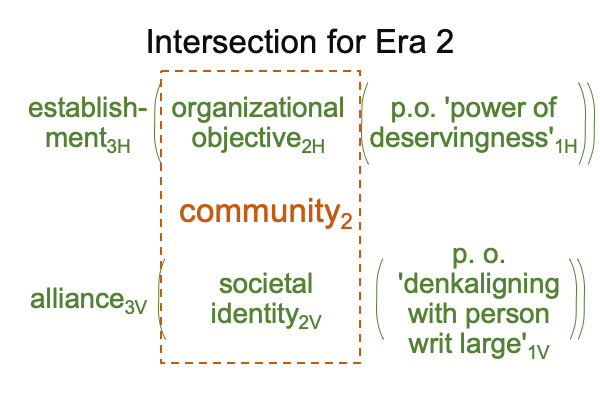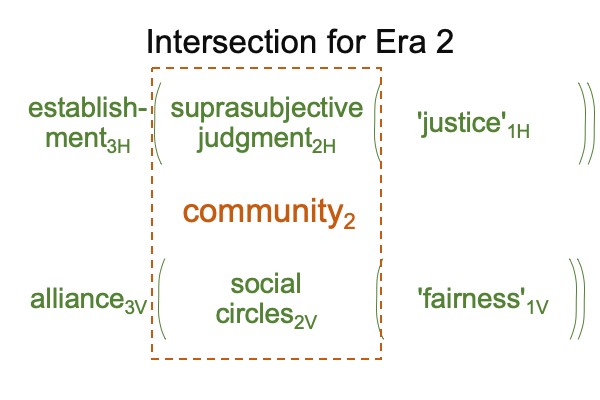0557 The tree of life represents the living and the dead.
The following proposed intersection for the era of collective intentionality does not quite capture poetic representation.

0558 I ask, “What tells me to bring the corpse of my father to the tree of life for preparation for burial?”
Does the tree of life tell me?
Is the tree of life an individual writ large capable of talking to me through its own version of hand talk?
Surely, the tree is planted by the one who gives, without us knowing why.
[POINT to sky] [CIRCLE POINT to all around][CIRCLE POINT to audience][PANTOMIME “give”]
0559 Perhaps, the apparent inadequacy of the prior intersection comes from the fact that the organizational objectiveassociates to societyC and social identity associates to the individual in communityA. So, organizationB polarizes between societyC and individualA.
That may be technically correct, but it does not move me towards the foundations of morality proposed by Scottish Enlightenment philosopher, David Hume.
0560 So, what if I return to the hylomorphe that associates to organizationB?
What if I substitute suprasubjective judgment or conviction for organizational objective2H?
What if I substitute social circles for societal identity2V?
0561 Then, the horizontal potential changes from the power of deservingness to… something close to the modern concept of “justice”.
And, the vertical potential changes from denkalignment with a person writ large to… something close to the modern concept of “fairness”.
Here is a picture.

0562 Thus, I arrive at the same final station as Tomasello does, in his natural history of human morality.
All may now disembark.
Plus, I arrive at a novel way to define key words that Hume applies to human morality.
0563 Justice1H underlies convictions2H. Justice1H is also the potential1H of underlying organizational objectives2H. Without justice1H, an organizational objective2aC will fail to interpellate individuals in communityA. With justice1H, an organizational objective2aC not only successfully calls the individualA into organizationB, but the individualA proves his or her worth. Worth is honor that is not bestowed, but rather demonstrated through committed action. With justice1H, deservingness has power, not the establishment’s definition of “power”, rather, the power of righteousness1aC. If justice1Hprevails, then establishment3H power2H is bestowed upon the deserving1H.
0564 Fairness1V underlies coming together into organization2V. Fairness1V is more than having fun1V. Fairness1V is the prerequisite for having fun. If I agreed to play a game, then discover that the game is unfair (that is, rigged), then why continue playing? The game is no longer fun.
One challenge faced by our ancestors in the era of collective intentionality becomes obvious. Some teams are more productive than others. Some teams have more fun than others. So, if team members start to denkalign with a team, as if the team provides their societal identity, then pride (in productivity) and guilt (in having good fun) are countered by resentment and jealousy (by those who denkalign with other teams).
Consequently, the team cannot provide a person with their societal identity.
There is someone more encompassing than any team. That larger than life person embraces all teams, from way back to now to way to come. That third person interpellates every you and every me. That person planted the tree of life. We are the roots. We are the branches.
